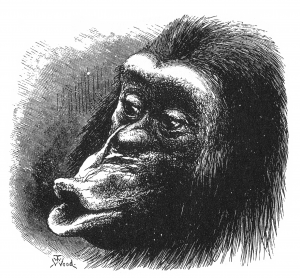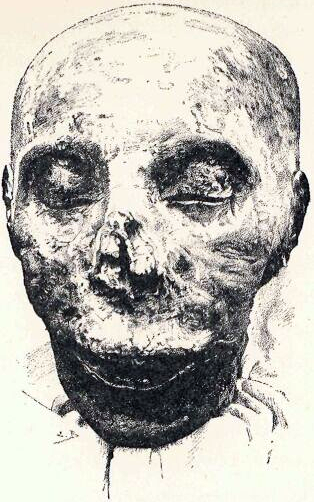A shockingly ghoulish chapter from the annals of American medicine was recorded following the death of New York coroner Dr. Thomas Holmes, who had stealthily been using unclaimed child cadavers to experiment with the mummification process. An excerpt from a story about his dark science which ran in the November 2, 1900 Brooklyn Daily Eagle:
“Dr. Holmes died January 8 of softening of the brain. He was at the time experimenting with embalming gas. The other day, through the Board of Health, the police removed all the specimens from the basement. They had been put in a box and had lain there almost untouched since Dr. Homes’ death. Their miscellaneous nature may be judged from the following report made by Dr. Wuest after an examination of the specimens of the morgue.The remains are: The mummified body of a male child, apparently 11 years old, with head, shoulders and arms missing. Had evidently been severed from the body with a saw and body was as hard as wood. Sections of skin cut. Whole length of remains, 39 1/2 inches. The body was mummified to such an extent that a crosscut saw went through it like pine wood. The consistency as of dry leather. The body was sawed across the bottom and then between the legs and spine. The remains were evidently many years old. With these remains were those of three other children. There was also removed from the place at the same time two mummified bodies of monkeys and one head of a monkey.

"There was also removed from the place at the same time two mummified bodies of monkeys and one head of a monkey."
The late Dr. Holmes was born at 42 Forsyth Street, Manhattan, in 1842. He studied medicine and graduated from the University of the City of New York. He soon afterward came to practice in the Eastern District, where he amassed considerable wealth. Shortly before the Civil War he bought about twelve lots on the east side of Marcy Avenue, between South Eighth Street and Division Avenue, and other property, and was at one time said to be worth $100,000. During the Civil War he volunteered as an embalmer and embalmed with a fluid which he prepared himself the bodies of 28,400 soldiers.
According to his widow, the doctor first attracted the attention of President Lincoln by embalming the body of Captain Ellsworth.
After the war Dr. Holmes returned to his home in the Eastern District. He at first resumed the practice of medicine, but as years went by began to devote more and more attention to the study of the embalming processes. At one time he thought he could preserve fresh beef and purchased for purposes of experiment an entire cargo of beefs from Texas. By this purchase the doctor lost nearly $17,000 because the beef all had to be destroyed.
After severe losses Dr. Holmes began to devote himself more exclusively to embalming human subjects, trying to invent what he described as the dry process–that is, embalming or preserving by use of gas. He claimed for his invention that it was superior to that used by the Egyptians four thousand years ago. On this process, it is said, he secured letters of patent. He obtained all the human subjects the remains of which have been found in the cellar from Bellevue Hospital, in Manhattan, where he was well known among students. The monkeys were given to the doctor by friends. Some years ago the doctor began to show decided signs of eccentricity. He put some of the stuffed animals in the windows of his home and this began to excite the curiosity of children going to school.

"At one time he thought he could preserve fresh beef and purchased for purposes of experiment an entire cargo of beefs from Texas."
One winter night two years ago, Dr. Holmes wrote a long incoherent letter to the city editor of the Eagle, in which the doctor hinted that he would divulge the secret of his discovery which he had at last perfected. A reporter called at the house and chatted with the doctor for over two hours. Whenever any question was put to him in regard to his invention, however, he evaded it. He would occasionally refer to the preservation of bodies and then divert to some meaningless narrative in regard to the war.”

